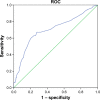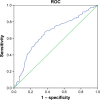Usefulness of neutrophil-to-lymphocyte ratio and platelet-to-lymphocyte ratio in hormone-receptor-negative breast cancer
- PMID: 27536129
- PMCID: PMC4973777
- DOI: 10.2147/OTT.S106017
Usefulness of neutrophil-to-lymphocyte ratio and platelet-to-lymphocyte ratio in hormone-receptor-negative breast cancer
Abstract
Purpose: We aimed to investigate the relationship between pretreatment neutrophil-to-lymphocyte ratio (NLR)/platelet-to-lymphocyte ratio (PLR) and the estimation of hormone-receptor-negative (HR-) breast cancer patients' survival in a Chinese cohort.
Patients and methods: Of 434 consecutive HR- nonmetastatic breast cancer patients treated between 2004 and 2010 in the Affiliated Hospital of Academy of Military Medical Sciences, 318 eligible cases with complete data were included in the present study. Kaplan-Meier analysis was performed to determine the overall survival (OS) and disease-free survival (DFS). Univariate and multivariate Cox proportional hazards models were used to test the usefulness of NLR and PLR.
Results: Univariate analysis indicated that both elevated NLR and PLR (both P<0.001) were associated with poor OS. The utility of NLR remained in the multivariate analysis (P<0.001), but not PLR (P=0.104). The analysis results for DFS were almost the same as OS. Subgroup analysis revealed a significant association between increased NLR and PLR (P<0.001 and P=0.011) and poor survival in triple-negative breast cancer. However, for human epidermal growth factor receptor 2-positive breast cancer, only NLR was significantly associated with OS in the multivariate analysis (P=0.001).
Conclusion: The present study indicates that both increased NLR and PLR are associated with poor survival in HR-breast cancer patients. Meanwhile, NLR is independently correlated with OS and DFS, but PLR is not.
Keywords: breast cancer; inflammatory markers; survival.
Figures






Similar articles
-
Are neutrophil/lymphocyte ratio and platelet/lymphocyte ratio associated with prognosis in patients with HER2-positive early breast cancer receiving adjuvant trastuzumab?J BUON. 2015 May-Jun;20(3):714-22. J BUON. 2015. PMID: 26214622
-
Prognostic Significance of Pretreatment Neutrophil-to-Lymphocyte Ratio, Platelet-to-Lymphocyte Ratio, or Monocyte-to-Lymphocyte Ratio in Endometrial Neoplasms: A Systematic Review and Meta-analysis.Front Oncol. 2022 May 16;12:734948. doi: 10.3389/fonc.2022.734948. eCollection 2022. Front Oncol. 2022. PMID: 35651788 Free PMC article.
-
Prognostic value of the neutrophil-lymphocyte, platelet-lymphocyte and monocyte-lymphocyte ratio in breast cancer patients.Oncol Lett. 2019 Dec;18(6):6275-6283. doi: 10.3892/ol.2019.10966. Epub 2019 Oct 8. Oncol Lett. 2019. PMID: 31788105 Free PMC article.
-
Prognostic value of neutrophil-to-lymphocyte ratio and platelet-to-lymphocyte ratio for breast cancer patients: An updated meta-analysis of 17079 individuals.Cancer Med. 2019 Aug;8(9):4135-4148. doi: 10.1002/cam4.2281. Epub 2019 Jun 13. Cancer Med. 2019. PMID: 31197958 Free PMC article.
-
The neutrophil lymphocyte ratio is associated with breast cancer prognosis: an updated systematic review and meta-analysis.Onco Targets Ther. 2016 Sep 8;9:5567-75. doi: 10.2147/OTT.S108419. eCollection 2016. Onco Targets Ther. 2016. PMID: 27660475 Free PMC article. Review.
Cited by
-
Link between Blood Cell-Associated Inflammatory Indices and Chemotherapy-Induced Hyperglycemia in Women Affected with Breast Cancer: Clinical Studies.South Asian J Cancer. 2023 Mar 9;12(2):118-125. doi: 10.1055/s-0043-1764316. eCollection 2023 Apr. South Asian J Cancer. 2023. PMID: 37969688 Free PMC article.
-
Prognostic role of derived neutrophil-to-lymphocyte ratio in surgical triple-negative breast cancer.Cancer Manag Res. 2018 Oct 24;10:4891-4898. doi: 10.2147/CMAR.S180695. eCollection 2018. Cancer Manag Res. 2018. PMID: 30425580 Free PMC article.
-
Impact of HER2 Status on Pathological Response after Neoadjuvant Chemotherapy in Early Triple-Negative Breast Cancer.Cancers (Basel). 2022 May 19;14(10):2509. doi: 10.3390/cancers14102509. Cancers (Basel). 2022. PMID: 35626113 Free PMC article.
-
Cancer stem cell-immune cell crosstalk in breast tumor microenvironment: a determinant of therapeutic facet.Front Immunol. 2023 Nov 27;14:1245421. doi: 10.3389/fimmu.2023.1245421. eCollection 2023. Front Immunol. 2023. PMID: 38090567 Free PMC article. Review.
-
Neutrophil to Lymphocyte Ratio as Prognostic and Predictive Factor in Breast Cancer Patients: A Systematic Review.Cancers (Basel). 2020 Apr 13;12(4):958. doi: 10.3390/cancers12040958. Cancers (Basel). 2020. PMID: 32295078 Free PMC article. Review.
References
LinkOut - more resources
Full Text Sources
Other Literature Sources
Research Materials

